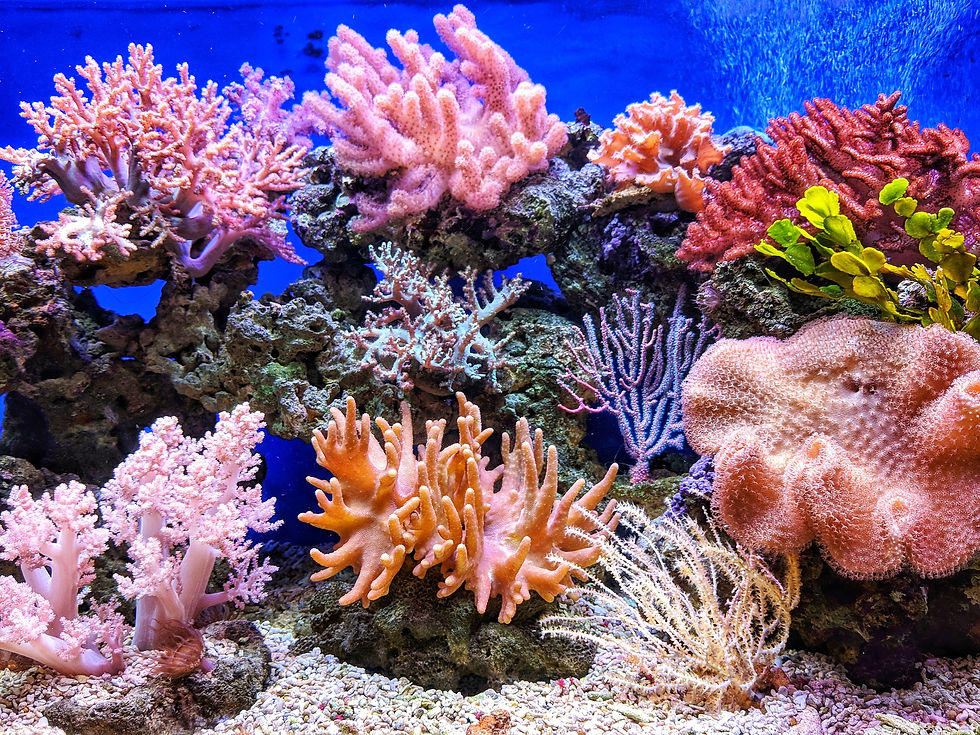How Does Fast-Fashion Pollute Our Oceans?
- Hannah Lumsden

- Jun 5, 2021
- 3 min read
Updated: Aug 16, 2021
Modern day fast-fashion relies on a very linear model of manufacturing known as ‘take, make, waste’ that can rapidly give consumers what they want, which in turn increases the appeal of it. But this infatuation with fast-fashion makes it all too easy to forget the damage that this process has on our environment and, more specifically, our oceans.
With the UN World Oceans Day being on June 8th this year, what better time is there to highlight the fashion industry’s biggest question: does fast-fashion pollute our oceans? What can we do to stop it?
How does fast-fashion impact our oceans?
Around two thirds of our clothes are made from synthetic fibres such as polyester, acrylic and nylon, all of which are plastics. Every time we wash our clothes, these plastics — known as microfibres — are released into the sewage system and carried away into wider bodies of water such as rivers and, eventually, the sea as they are far too small to be collected by any of the wastewater treatment plants.
In fact, researchers at Ocean Wise, a marine conservation organisation, discovered that for only one clothes wash, up to 700,000 fibres could come off the clothes and potentially travel to the oceans. Globally, that totals half a million tons of small plastic fibres into the ocean. That’s equivalent to 50 billion plastic bottles!
Not only that, but many dyeing and finishing processes required for fast-fashion rely on toxic chemicals that leach out into rivers and groundwater systems, degrading the land, compromising drinking water and killing fish.
Furthermore there is also evidence that microfibres are accumulating in the food chain because they are a part of the overall microplastic pollution, which means that more often than not marine life mistakes the fibres for food. This causes damage to the sea creatures of course, but when humans or other animals eat the aforementioned creatures, they too ingest the microfibres, which are not good for our internal health.
So what is being done to stop this plastic pollution?
There are, however, steps being taken in the right direction to reduce the amount of microfibres being released into our oceans. In 2011, for example, the environmental charity Greenpeace launched its Detox campaign, which challenged big companies within the fashion industry to take responsibility for the environmental damage caused by their supply chains, as well as to commit to reducing their discharge of hazardous chemicals.
Though 80 companies signed up to this campaign and progress has been made, they still only represent 15% of the industry on a global scale.
Scientists have also been taking advantage of London Fashion Week in recent years and used it as a platform to highlight the impact of microplastics in clothing, which is a less commonly known source of marine pollution to consumers, according to this article by Intelligent Living.
They urge fashion brands to promote slower fashion — which does not follow the linear manufacturing model and lasts longer — and more sustainable clothing items so consumers will be less inclined to purchase fast-fashion. As these microfibres have been most frequently found within fast-fashion, it is vital that consumers have more awareness about the kinds of clothing they are buying.
What can consumers do?
As consumers there are steps we can take to make a more positive impact on our oceans and aquatic life. Firstly, shop more consciously. There are fashion brands out there who are very transparent about their manufacturing process and trace their materials back to the source, meaning that they are intentionally making an effort to reduce the microfibres in their clothes.
Engaging in the circular fashion economy is also essential; buying less clothes of higher quality that will last longer and recycling clothes you no longer use means that hundreds of thousands of microfibres will remain inside the clothes instead of floating alongside marine life and damaging their internal organs.
Simply washing your clothes less often has a massive impact too. Or, if there needs to be a constant cycle of washing in your house, wash smaller loads at low temperatures to severely reduce the amount of microplastics that are released.
Avoid tumble drying and opt for a drying rack instead. There are also microfibre capture filters available to buy for washing machines, which although don’t capture 100% of microfibres, are a massive step in the right direction.
For our oceans to truly be saved, of course, the fashion industry really needs to step up its game and accept responsibility for the detrimental damage they cause to the planet. But as consumers of fashion we also have a duty to help clear our oceans of microfibres and promote more sustainable clothing that doesn’t harm any sea creatures or end up in our own food.
If every household took initiative, by 2050 the oceans would be 50% clearer than they are today and fashion could return to being much slower and much more circular.



Comments